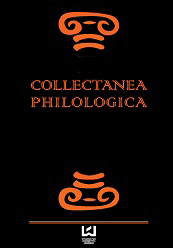Sacerdote e re. Potere religioso e potere regale
dall’Oriente all’Occidente.
Priest and King. Religious and Royal Power from East to West.
Author(s): Orazio Antonio BolognaSubject(s): Christian Theology and Religion, Cultural history, Studies of Literature
Published by: Wydawnictwo Uniwersytetu Łódzkiego
Keywords: king; religion; priest; Troy
Summary/Abstract: The short work, analyzing the concept of the priesthood and that one, politically more important, of the king was inspired by the short passage of the Iliad, where, in the first book, the poet compares two important figures: Crise, priest of Apollo and Agamemnon, king of the Achaeans. The meeting is placed under the walls of Troy, where the Greeks fight, to avenge the abduction of Helen. Crise, with the priestly bandages on his head and the scepter in his hands, symbols of the high office and of his dignity, goes to Agamemnon to ransom his daughter that was captive concubine of the Greek sovereign. Agamemnon refuses the ransom and deeply offends the priest of Apollo. From this brief episode, the author looks at priesthood as it was understood among the peoples of the Near East, that have had a considerable influence on the rising culture and Greek civilization. The reference to the Iliad is limited to the Middle (Near) East, but in regard to the gods, with the characteristics that distinguish them, all belong to the Greek mainland. The presence ofMount Ida, located not far from Troy, leads to a broader discussion, to highlight links do not yet sufficiently clarified. The two high offices, priesthood and royalty, as seen at theSumerian and Jewish civilization, were once united in the hands of a single person; but in time they are so deeply divided and diversified, so that, both of them, the priest and the king are considered the holder of absolute and independent power. Religion is the key concept, which is adopted for the first approach, when you are analyzing a given culture. Crise, with the priestly bandages on his head and the scepter in his hands, embodies the primary essence of the priest, considered as the religious and political leader; Agamemnon, however, in line with the evolution process of the society, is seen only as the political leader.
Journal: Collectanea Philologica
- Issue Year: XVIII/2015
- Issue No: 1
- Page Range: 5-16
- Page Count: 12
- Language: Italian

